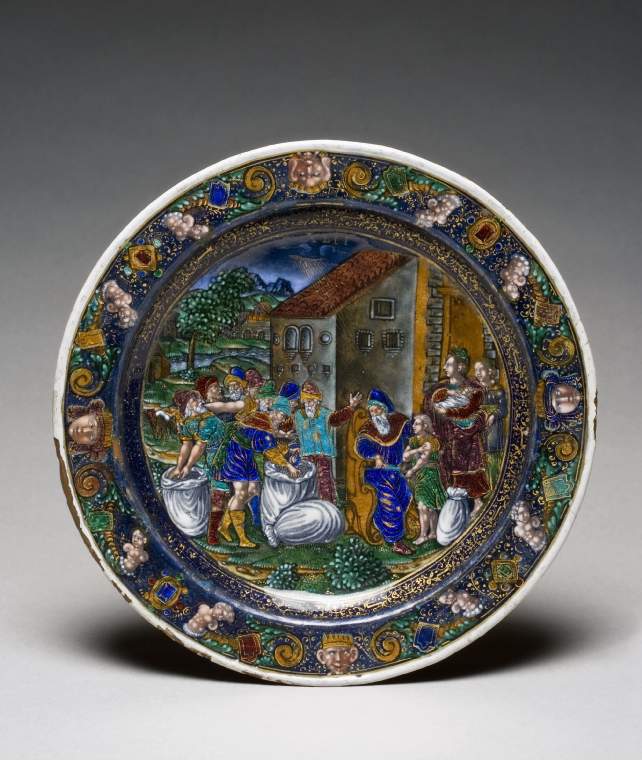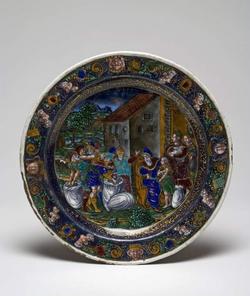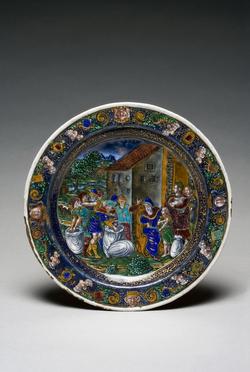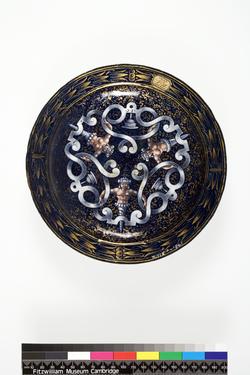Current Location: In storage
Titles
Joseph's brothers find their money returned to them in their sacks
Maker(s)
Maker:
Court dit Vigier, Jean I
(Possibly)
Maker:
Court dit Vigier, Jean II
(Possibly)
Entities
Categories
Description
Copper, decorated with polychrome enamels over paillons and gilded; the reverse enamelled in grisaille and gilded, with terms, torches, and strapwork, initialled ".I.C."
Circular with slightly raised applied edge, narrow sloping rim, shallow curved sides and centre. Round the junction of the rim and well on the back there are a series of holes in the enamel left by supports during firing.The plate has a dark blue ground. The design in the well is enamelled over a white layer in dark blue, translucent blue, turquoise, green, yellow, red, mulberry, and brown with silver foils (paillons) under the costume, and in black, opaque white, flesh-pink, and opaque white, enhanced with gilding. The sides are decorated in gold over the dark blue ground. The motifs on the rim are executed in translucent enamels over foils and in flesh-pink, white and grey over a white ground, reserved in a dark blue ground with gilt ornament. The reverse is enamelled in grisaille and with flesh pink, and gilding.
The well is decorated with Joseph's brother's showing Jacob that their money has been returned to them in their sacks of grain. The action takes place out of doors, with two buildings in the background to right, a landscape with a stream on the left, and a path and two bushes in the foreground. A woman holding a baby in her arms and another woman stand on the right with a small sack in front of them. Benjamin stands beside his father, Jacob, who is seated in a chair. To the left, there is a sack lying sideways on the ground, and two more upright, which are being searched by two of the brothers. Six more of them stand behind them, one raising his arms in a gesture of surprise. In the sky above, in gold, is ".G.XLII" with below it, gold rays streaming down towards Benjamin. The sides are decorated with gold foliated scrolls on a dark blue ground, and on the rim, two different male and two different female masks, separated by tritons with tablets over their scrolling tails flanking jewels, with gold foliated sprays on a black ground. The edge is white.
The reverse is painted in grisaille and flesh pink with two female terms and one male [?] term and three torches without flames linked by strapwork. The dark blue ground is decorated with gold sprays and foliate scrolls. On the rim there is a wreath of gold leaves and berries between pairs of gold bands. On the back, "I.C" in black on white strapwork below one of the torches.
Notes
History note: Baron James de Rothschild (1792-1868); his son, Baron Gustave de Rothschild (1829-1911), Paris; by descent to his grandchildren, Sir Philip Sassoon and the Countess of Rocksavage; sold Christie’s, 26 November 1919, Catalogue of Objects of Art Porcelain & Faience, Fine French Tapestry, the property of Sir Philip Sassoon, BT., M.P., C.M.G., and the Countess of Rocksavage of 25 Park Lane, p. 8, part of lot 63; Walter Walter S. Burns, Esq., North Mymms Park, Herts; Mrs Walter Burns; Christie's, 28 June 1935, Catalogue of highly important enamels, faience and majolica and works of art, the property of Mrs Walter Burns (from the Collection of the late Walter S. Burns, Esq.) . . . . , lot 11, III; Louis C.G. Clarke, MA, LL.D., Leckhampton, Cambridge.
Legal notes
Louis.C.G. Clarke Bequest, 1960
Measurements and weight
Diameter: 19.8 cm
Height: 2.2 cm
Acquisition and important dates
Method of acquisition: Bequeathed
(1961-04-27)
by
Clarke, Louis Colville Gray
Dating
16th Century, Late-17th Century, Early
Circa
1585
CE
-
1600
CE
Note
The Biblical story of Joseph told in Genesis, was a common theme for the decoration of domestic objects in France in the second half of the 16th century. Limoges enamellers decorated caskets, ewers, dishes, and small plates with Joseph scenes. Although no complete sets are known, this plate was probably one of a set of twelve each decorated with a different event in the story, beginning when Joseph was already the slave of Potifar in Egypt, and extending from his rejection of the enticements of Potiphar’s wife (Genesis 39.7) to his reconciliation with his brothers (Genesis 45.14-16). Ten of the scenes were closely based on Bernard Salomon's woodcut illustrations to Claude Paradin’s 'Quadrins historiques de la Bible', first published by Jean de Tournes in Lyon in 1553. An augmented edition appeared in 1555, reprinted in 1558 and 1560, and another augmented edition in 1583. Each page had the biblical reference at the top, a woodcut, and an explanatory verse below. Another work of the same type, Guillaume Guéroult’s 'Figures de la Bible illustrées de huictains francoys . . . (Guillaume Roville), Lyons, 1564 (2nd edn, 1565), with illustrations by Pierre Vase/Eskrich was used for the 7th and 10th plates in the series, and the 12th has aspects from the woodcuts in both publications. These books can be seen online in the website Gallica of the Bibliothèque nationale. The story of Joseph was also recounted at length by the Jewish historian, Flavius Josephus (c. 37 BC - after 100 AD), in his Antiquities of the Jews, Book II, II–VII. This work was widely read in sixteenth-century France, and the Lyon edition of 1562, 'l’Histoire de Fl. Josephe, Sacrificateur Hebrieu', translated by François Bourgoing, and printed by Jean Temporal for Jean de Tournes, illustrates the part of Joseph’s story which appears on the Limoges plates with Salomon’s twelve woodcuts for those scenes, but without the biblical reference. It is therefore possible that the enameller could have used that rather than 'Quadrins historique de la Bible'.
This subject, the ninth in the sequence, was taken from the Book of Genesis 42 Joseph’s brothers returned home to their father Jacob, having left Simeon behind in Egypt as a hostage. When they unpacked their sacks of grain, they discover that their money has been returned to them in their sacks. The scene was after the woodcut titled GENESE XLII’ by Bernard Salomon in Claude Paradin’s, Quadrins Historique de la Bible, Lyon (Jean de Tournes), 1553 or a later edition. The plate was misidentified in the catalogue of the 1865 Musée retorspectif as Joseph selling corn to his brothers, and later as the Betrayal of Benjamin, and as the Finding of the Cup in Benjamin's Sack, which occur later in the story.Another plate decorated with this subject formerly belonged to Baron Ferdinand Anselm de Rothschild (1839-98), and is part of the Waddesdon Bequest in the British Museum (WB34) (see Documentation)
The plate has a blue ground, like those in a part set of six plates in the Louvre, which were acquired in 1794 having been seized for the state in 1793 from the collection of Louis-Hercule-Timoléon, duc de Brissac (1734-1792) then in the hôtel Talleyrand-Péricord. The plates in that group however, are a little larger than this plate, 20.2 cm in diameter, and have different border designs on the rim, so although this subject is missing from that set (if it originally had twelve plates), the plate seems unlikely to have been part of it.
The overall appearance of these plates, the border on the fronts, and the style of grisaille decoration on the reverses, is comparable to a set of plates decorated with scenes from the Life of the Virgin signed' I.C.' . These have the de Vic arms below on the rims, probably for Méry de Vic (d. 1622), who had been resident in Limoges as intendant during 1588 and 1589, while on a mission to restore order in the region for Henry III, and after his assassination in August 1589, had transferred his allegiance to Henry IV. It seems likely that the plates were made about that time, and if not, before 1603 when a change was made to the de Vic arms.
The initials ‘'I•C.’ occur on a great many Limoges enamels made during the second half of the 16th and early seventeenth century. The plate therefore seems likely to have been a workshop mark used successively by members of the Court family. These were Jehan/Jean Court dit Vigier I (d. 1592), whose earliest known signed work was dated 1555, and his son, Jean Court dit Vigier II (b. c.1575; d. between 1631-5); a Jehan/Jean de Court who witnessed the latter's wedding in 1598, and was therefore probably a relative (if he were an enameller which is not certain), and a related enameller, Jehan/Jean Court dit Vigier le jeune who married in 1613, and died between 1627-31. (See Documentation, Beyssi-Cassan, 2006).
School or Style
Renaissance
Mannerism
People, subjects and objects depicted
Components of the work
Decoration
composed of
enamel
( dark blue, translucent blue, turquoise, green, yellow, red, and mulberry, flesh-pink, brown, grey, opaque white, and black)
silver-foil
gold
Materials used in production
Copper
Techniques used in production
Raising (metal forming process)
: The well has a partly foiled and partly white ground, decorated with dark blue, translucent blue, turquoise, green, yellow, red, and mulberry, flesh-pink, brown, grey, opaque white, and black enamels, and gold. The sides are decorated in gold on a dark blue ground. The motifs on the rim are executed in translucent enamels over foils and in flesh-pink, white and grey over a white ground, reserved in a dark blue ground with gilt ornament. The reverse has a dark blue ground, painted in grisaille and with flesh pink, and gold. Round the junction of the rim and well on the back there are a series of holes in the enamel.
Inscription or legends present
- Text: .G.XLII
- Location: On front in sky
- Method of creation: Painted in gold
- Type: Inscription
- Text: .I . C.
- Location: On back on white strapwork below one of the torches
- Method of creation: Painted in black
- Type: Initials
Inscription present: rectangular paper label with cut corners
- Text: UNION/CENTRALE’ printed in black, with between the words in faded black ink, 124/2788
- Location: On back of rim
- Method of creation: Printed in black and hand-written in faded black ink
- Type: Label
References and bibliographic entries
-
Exposition de 1865. Palais de l’Industrie, Musée Rétrospectif. Catalogue des objets d’art et de curiosité exposés au Musée Rétrospectif ouvert au Palais de l’Industrie en 1865
page(s): 225
-
Catalogue of objects of art, porcelain and faience and fine French tapestry, the property of Sir Philip Sassoon Bart, MP, CMG and the Countess of Rocksavage of 25 Park Lane
page(s): 8
-
Catalogue of highly important enamels, faience and majolica and works of art, the property of Mrs. Walter Burns (from the Collection of the late Walter S. Burns, Esq.
-
L’histoire de Joseph sur des assiettes en émail peint de Limoges par l’atelier portant la marque de fabrique “I.C.
page(s): 136-7
-
Quadrins Historique de la Bible
-
Bernard Salomon Illustrateur Lyonnais
-
Les émaux peints de Limoges. Musée du Louvre, Département des objets d'art
page(s): 350-7
-
The Waddesdon Bequest; Catalogue of the Works of Art bequeathed to the British Museum by Baron Ferdinand Rothschild M.P. 1898
page(s): 29
-
The Taft Museum, European Decorative Arts
page(s): 382- 4
-
Emaux de Limoges de la Renaissance provenant de la collection de M. Hubert de Givenchy
page(s): 64-7
-
Le métier d’émailleur à Limoges, XVIe-XVIIe siècle
page(s): 378-80
-
Collection Yves Saint Laurent et Pierre Bergé, Sculptures, Objets d'Art, Art d'Asie, Archéologie et Mobilier
page(s): 228-9
-
The Wallace Collection, Catalogue of Glass and Limoges Painted Enamels
page(s): 311
-
Sir Philip Sassoon at 25 Park Lane: the collection of an early twentieth-century connoisseur and aesthete
page(s): 151-70
Related exhibitions
Identification numbers
Accession number: M.115B-1961
Primary reference Number: 156461
Stable URI
Audit data
Created: Saturday 6 August 2011
Updated: Tuesday 5 November 2024
Last processed: Thursday 14 August 2025
Associated departments & institutions
Owner or interested party:
The Fitzwilliam Museum
Associated department:
Applied Arts

 IIIF Manifest
IIIF Manifest








